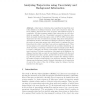Free Online Productivity Tools
i2Speak
i2Symbol
i2OCR
iTex2Img
iWeb2Print
iWeb2Shot
i2Type
iPdf2Split
iPdf2Merge
i2Bopomofo
i2Arabic
i2Style
i2Image
i2PDF
iLatex2Rtf
Sci2ools
SSD
2009
Springer
2009
Springer
Analyzing Trajectories Using Uncertainty and Background Information
A key issue in clustering data, regardless the algorithm used, is the definition of a distance function. In the case of trajectory data, different distance functions have been proposed, with different degrees of complexity. All these measures assume that trajectories are error-free, which is essentially not true. Uncertainty is present in trajectory data, which is usually obtained through a series of GPS of GSM observations. Trajectories are then reconstructed, typically using linear interpolation. A well-known model to deal with uncertainty in a trajectory sample, uses the notion of space-time prisms (also called beads), to estimate the positions where the object could have been, given a maximum speed. Thus, we can replace a (reconstructed) trajectory by a necklace (intuitively, a a chain of prisms), connecting consecutive trajectory sample points. When it comes to clustering, the notion of uncertainty requires appropriate distance functions. The main contribution of this paper is t...
Related Content
| Added | 27 May 2010 |
| Updated | 27 May 2010 |
| Type | Conference |
| Year | 2009 |
| Where | SSD |
| Authors | Bart Kuijpers, Bart Moelans, Walied Othman, Alejandro A. Vaisman |
Comments (0)

